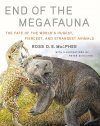![American Megafaunal Extinctions at the End of the Pleistocene American Megafaunal Extinctions at the End of the Pleistocene]()
Click to have a closer look
About this book
Contents
Customer reviews
Biography
Related titles
Recommended titles
About this book
This volume contains summaries of facts, theories and unsolved problems pertaining to the unexplained extinction of dozens of genera of mostly large terrestrial mammals, which occurred circa 13,000 calendar years ago in North America and about 1,000 years later in South America. Another equally mysterious wave of extinctions affected large Caribbean islands around 5,000 years ago.
The coupling of these extinctions with the earliest appearance of human beings has led to the suggestion that foraging humans are to blame, although major climatic shifts were also taking place in the Americas during some of the extinctions.
Different chapters in this book provide in-depth resumes of the chronology of the extinctions in North and South America, the possible insights into animal ecology provided by studies of stable isotopes and anatomical/physiological characteristics such as growth increments in mammoth and mastodont tusks, the clues from taphonomic research about large-mammal biology, the applications of dating methods to the extinctions debate, and archeological controversies concerning human hunting of large mammals.
Contents
Chapter 1: Introduction to the volume, Gary Haynes
Chapter 2: Sudden deaths: the chronology of Terminal Pleistocene megafaunal extinction, Stuart Fiedel
Chapter 3: Estimates of Clovis-era megafaunal populations and their extinction risks, Gary Haynes
Chapter 4: Paleobiology and extinction of proboscideans in the Great Lakes region of North America, Daniel C. Fisher
Chapter 5: Human prey choice in the Late Pleistocene and its relation to megafaunal extinctions, Todd A. Surovell and Nicole M. Waguespack
Chapter 6: Ancient DNA and the genetic consequences of Late Pleistocene extinctions, Alex D. Greenwood
Chapter 7: Did humans cause the Late Pleistocene-Early Holocene mammalian extinctions in South America in a context of shrinking open areas? Alberto L. Cione, Eduardo P. Tonni, and Leopoldo Soibelzon Chapter 8: The elusive evidence: the archeological record of the South American extinct megamammals, Luis Alberto Borrero
Chapter 9: Insulae infortunatae: establishing a chronology for Late Quaternary mammal extinctions in the West Indies, R.D.E. MacPhee
Chapter 10: Afterword, and thoughts about the future literature, Gary Haynes
Customer Reviews
Biography
Gary Haynes, archeologist and author of two related books, Mammoths, Mastodonts, and Elephants (Cambridge University Press, 1993) and The Early Settlement of North America: The Clovis Era (Cambridge University Press, 2002). He has spent nearly 30 years working in actualistic studies of large-mammal bones in Africa, Australia, and North America, and has also been deeply involved in Paleoindian research for even longer.















































